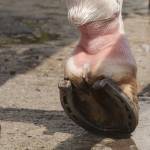Navicular Disease in Horses: What Is It?

Disease of the navicular bone, also called the distal sesamoid bone, and its associated soft tissues are often at the root of chronic forelimb lameness. Though young horses might be affected, navicular disease typically crops up in mature riding horses.
Conformation may play a role in the development of the disease. Stock-type horses with small, boxy hooves that appear proportionately small to body size seem to be affected frequently, as do Warmbloods that have tall, narrow hooves. Those with low, collapsed heels, such as certain Thoroughbreds, might also be diagnosed if chronic lameness becomes an issue. Horses with front hooves that are significantly different in shape are predisposed as well.
Aside from conformation, compressive forces and stress on the navicular bone and adjacent soft-tissue structures seem to be the primary causes, but this is speculative because the disease cannot be reproduced experimentally. Incidence of navicular disease is more common in horses that compete in high-level competition than in those that engage in low-intensity activities.
Lameness is the primary sign of navicular disease, though horsemen may sense various changes in way of going leading up to unsoundness, including a shortening of stride, general stiffness, and unwillingness to go forward. Lameness usually becomes accentuated when horses are asked to move in circles on a hard surface.
Radiographs are useful in diagnosing navicular disease, and veterinarians will generally take multiple views to ensure that even the most subtle changes are detected. Various radiological changes to the bone verify a positive finding. These include, but are not limited to, changes in the shape of the entire bone or to margins of the bone, formation of cyst-like lesions, and erosions of the bone. Generally, the more radiological changes found to the navicular bone, the more likely the horse has navicular disease.
Other diagnostic methods, including nuclear scintigraphy, computed tomography (CT scan), and magnetic resonance imaging (MRI), may be of some use in diagnosing disease, considering these are generally more sensitive than radiography.
Appropriate management of navicular disease often depends upon a skilled farrier that is versed in trimming and shoeing horses with the diagnosis. Correction and maintenance of hoof balance, ease of breakover, and protection of the palmar aspect or heel area, of the hoof from concussion are primary considerations in shoeing a horse with navicular disease.
Medication might be part of the management scheme and may include nonsteroidal anti-inflammatories (NSAIDs) at low doses and a vasodilator such as isoxsuprine. Two new bisphosphonates, tiludronate disodium and clodronate disodium, are being used with positive results, extending the athletic longevity of many horses affected by navicular disease.








